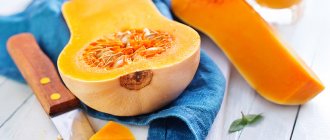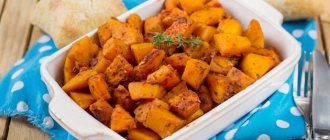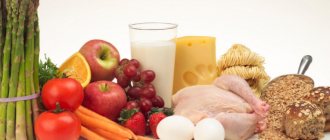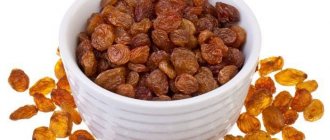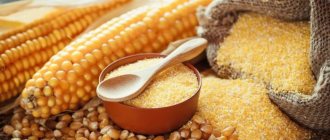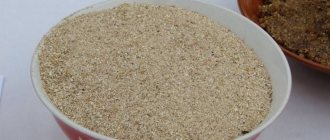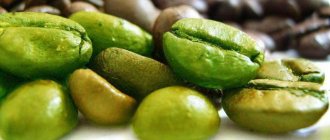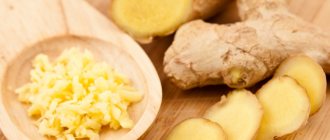Compound
Everyone is confident in the low calorie content of zucchini.
But this is the closest relative of the pumpkin. For clarity, let’s compare the calorie content and nutritional value of both vegetables. The table shows their chemical composition: it is a low-calorie product; The composition of pumpkin and its comparison with zucchini allows us to draw the following conclusions:
- 100 grams of pumpkin contains more protein, but less fat and carbohydrates than zucchini;
- it contains a lot of dietary fiber (pectin, fiber), which makes the vegetable filling and beneficial for digestion;
- There are relatively few saccharides, it is even recommended for diabetes;
- both vegetables contain very few organic acids, so they are allowed even during inflammatory processes in the digestive organs;
- like in zucchini (and in cucumbers too), the pumpkin contains more than 90% water.
Add to this an abundance of vitamins, macro- and microelements. The leader among vitamins is vitamin C (per 100 g – 15 mg). The vegetable is rich in beta-carotene, thiamine, riboflavin, folic and nicotinic acid, biotin, etc. It contains a lot of potassium, so it is recommended for diseases of the cardiovascular system and edema. Pumpkin will enrich the body with calcium, magnesium, sodium, iron, phosphorus and cobalt.
100 grams of pumpkin cover 6.7% of the daily requirement for dietary fiber, 5% for organic acids; 8% is in vitamin B3, 8.9% is in C, 8.2% is in potassium and 10% is in cobalt.
Take full advantage of the unique properties of the vegetable by arranging fasting days with it. 1.5 kg of pumpkin should be baked in a heated oven for 10 minutes to make it softer. This way it is better absorbed. Divide the daily dose into several doses.
Calorie content of pumpkin dishes
Convincing information about the vegetable as a dietary and “correct” product concerns only raw pumpkin.
How do calorie content and its composition change depending on the cooking method? Over the long history of pumpkin’s popularity, many recipes have accumulated. Their calorie content per 100 grams is shown in the table:
As you can see, there are few calories in pumpkin dishes. Meanwhile, its unusual taste will diversify the traditional menu and make it much healthier.
Raw pumpkin
Pumpkin pulp is good to eat raw. All the benefits are preserved in it and the calorie content is low. For this purpose, choose sweet nutmeg varieties. Peel the fruits from the dense peel and seeds, cut into cubes - the fragrant, juicy fruits are ready. You can prepare dietary but satisfying salads - with apples, nuts, vegetables, cheese, etc.
Boiled pumpkin
This is a light product, easy to prepare.
You need to cook the peeled pieces for no more than half an hour. If they seem too bland, you can dust them with sugar and cinnamon. But the calorie content of such a dish will increase significantly - from 37 to 127 calories per 100 grams. If you grind a boiled vegetable in a blender, you get a tasty puree. Pumpkin puree is one of the first baby foods. Its taste is richer and not as bland than that of zucchini puree.
Baked pumpkin
You can make a delicious low-calorie dessert from baked vegetables. A popular recipe is with honey, apples and orange. Peel a kilogram of pumpkin and 2 apples, cut them into cubes, squeeze orange juice on them and add 2 tbsp. honey
Baking is another way to prepare vegetable fruits. Baked pumpkin is a frequent guest on the table of those losing weight due to its low calorie content and good digestibility. To make it soft, you need to bake it in foil for 20 minutes.
Stewed pumpkin
This can be an excellent side dish for meat or fish. A tasty vegetable, the calorie content of which when stewed does not exceed 60 calories, is an excellent alternative to potatoes. But remember that additional ingredients (butter, milk) sharply increase the calorie content of the dish.
Healthy pumpkin dishes
Those who have already introduced pumpkin dishes into their diet appreciated the tasting and beneficial properties of the product. Pumpkin can be consumed either raw or cooked. Below are some simple recipes for pumpkin cooking options.
Recipes for making salads from raw vegetables
In order to add pumpkin to a salad, take ripe fruits with dense, edible pulp.
Salad with apple and pumpkin
- fresh pumpkin (400 g) is chopped on a coarse grater;
- 1 sour apple, peeled and seeds removed, cut into thin slices;
- After mixing the products, add finely chopped green onions;
- season with salt and sugar to taste.
Fill the ingredients with sour cream and serve the salad.
Apple-pumpkin salad with honey
- 600 g of firm ripe pumpkin pulp and 5 apples are grated;
- zest from 2 lemons and juice are added to the prepared mass;
- season with honey to taste and add ground walnuts.
You can also use hazelnuts or hazel.
Vegetable salad
- 200-250 g of fresh pumpkin, grated;
- tomatoes (3 pcs.) and bell peppers (2 pods) cut into cubes;
- a small onion is cut into thin rings;
- mix all the vegetables, adding crushed garlic (2-3 cloves) and herbs;
- salt to taste, sprinkle with vinegar (1 tsp) or lemon juice;
- season with olive oil.
Those who like it spicy can add a little ground black pepper or crushed capsicum to the salad. The dish can also be supplemented with pitted olives.
Baked Pumpkin Recipes
Pumpkins baked in the oven do not lose their healing properties, but acquire taste. The proposed recipes will be an excellent addition to the diet menu.
Pumpkin baked in the oven with honey
- fresh pumpkin (400 g) cut into small pieces;
- honey (2 tbsp) mixed with vegetable oil (1 tbsp);
- Roll the pumpkin in the prepared sauce and place it on a baking sheet.
Bake in a preheated oven for 40 minutes at 180 degrees.
Pumpkin in sour cream
You can bake pumpkin pieces in the oven without anything, and then serve with sour cream, or you can do it differently:
- salt the slices (0.5 kg) and roll in flour;
- fry in butter, place on a baking sheet;
- pour in whipped sour cream (150 g) and put in the oven.
This recipe can be varied by replacing the fermented milk product with sour cream sauce, adding eggs, spices and herbs.
Boiled pumpkin dishes
Pumpkin is added to first courses and delicious porridges are prepared from it, which children really like.
Rice porridge with pumpkin
- pumpkin (1 kg) is poured with water so that it lightly covers the chopped vegetable;
- salt to taste and, adding 200 g of rice, cook until the cereal is completely cooked;
- At the end of cooking, add butter (100 g).
If desired, water can be replaced with milk, and rice with millet or semolina. Porridge is served with sour cream, syrup or jam (as you like).
Sweet porridge
- heat milk (400 g) and add pumpkin cubes (300 g);
- add salt to taste, add sugar and bring to a boil;
- add millet (6 tbsp) and cook the porridge, adding butter (1 tbsp) at the end.
The sweet dish is served with fresh berries as a dessert for tea.
Cream soup
- pumpkin (0.5 kg) and carrots (3 pcs.) cut into cubes;
- vegetables are placed in a pan and poured with boiling water (1 l);
- add salt and sugar to taste and cook until the products soften;
- rub the soup through a sieve;
- grind flour (2 tbsp) in half a glass of water and add to the puree;
- adding tomato paste (2 tbsp), cook for a few more minutes.
Before removing from the stove, the puree soup is diluted with boiled milk (2 cups) until the consistency of sour cream. When serving, season with butter.
Soup with mushrooms and apples
- boil mushrooms (200 g) and simmer in vegetable oil along with parsley or celery root;
- 2 potatoes and pumpkin (200 g) cut into strips;
- Boil vegetables until half cooked;
- add mushrooms, tomato slices and sour apple;
- cook until fully cooked.
When serving the soup to the table, season with sour cream and sprinkle with green onions.
Calorie content of pumpkin seeds
If the taste of the pumpkin itself seems unusual to some, then everyone usually loves the seeds. Moreover, they are recommended as a natural medicine for diseases of the cardiovascular and digestive systems. Pumpkin seed fiber cleanses the body and saturates it well. And its anthelmintic properties are known to everyone. But do lovers of pumpkin delicacy know that its calorie content is very high? Due to the oils contained in 100 grams of seeds - 556 calories! Therefore, pumpkin seeds, the benefits and harms of which are inseparable, should be consumed with caution by those on a diet. Like nuts, you can eat a lot of them.
A vegetable with a bright appearance has a bright taste. Decorate not only your home with it, but also the healthy menu of your loved ones.
Pumpkin jam
Pumpkin jam attracts with its beautiful amber color, intriguing taste and piquant aroma, which provides the presence of all kinds of spices. This dessert will diversify your diet, fill it with vitamins and other substances important for the body. In addition, with the help of pumpkin jam, this melon can be put to good use during the big harvest season. This delicacy will surely become the most favorite pumpkin dish, which, thanks to many interesting additives, will appeal to all its tasters.
Pumpkin and zucchini jam
Ingredients:
950 g pumpkin, 950 g zucchini, 1700 g sugar, 145 g lemon, 140 g raisins, 180 g dried apricots, 370 ml water.
Preparation:
- We wash the dried fruits.
- Add boiling water and leave them in for 15 minutes.
- Wash the vegetables and remove the skin.
- We extract the seeds from the pumpkin.
- We weigh the peeled vegetables - their mass should be equal to the weight of sugar or a little more if the pumpkin is very sweet.
- Remove the yellow part of the zest from a well-washed citrus. Grate it.
- We clean the lemon from white veins and seeds.
- Grind the pumpkin, zucchini, dried apricots, and lemon in a meat grinder.
- Sprinkle raisins, sugar, chopped zest into the mixture. Stir.
- Warm up slowly, stirring constantly. Boil for 30-50 minutes until thickened. In the process, remove the foam and stir so that the dish does not burn.
- Pour the pumpkin-squash jam into clean, warm jars.
- Let's roll up.
- Place the lids down. Turn over after 15 minutes.
Pumpkin and apple jam
Ingredients:
470 g pumpkin, 310 g sour apples, 440 g sugar, 4 g cinnamon, 580 g water, 120 g walnuts.
Preparation:
- Wash pumpkin and apples.
- We clear them of seeds.
- Cut out the fibrous part of the pumpkin pulp where the seeds are located and remove the peel.
- We cut the prepared products into cubes.
- Cut the peeled nuts into pieces of arbitrary shape.
- Fry without oil for about 7 minutes, stirring occasionally.
- Pour water into the pan and place the pumpkin pieces. With constant heating and stirring, add sugar.
- After boiling, add apples. Boil for half an hour, skimming off the foam.
- Add nuts to the jam and add cinnamon. Boil slowly, stirring, for 20 minutes. Transfer to clean, dried jars.
- Place parchment paper on top, cut to the size of the neck diameter. Store in the cold.
Pumpkin jam with cherry plum
Ingredients:
1070 g pumpkin, 1070 g cherry plum, 1100 g sugar, 180 ml water.
Preparation:
- Wash the pumpkin and cherry plum.
- Cut the skin off the pumpkin and remove the seeds.
- Cut the pulp into cubes.
- We peel the cherry plum from the pits.
- We boil water. Blanch the pumpkin for 10 minutes. Add cherry plum and keep on heating for another 6 minutes.
- Grind the softened ingredients with the broth in a blender or pass through a sieve. While heating slowly, add sugar.
- Stirring constantly, boil for a couple of minutes.
- Pour into sterile, dried jars.
- We seal it hermetically.
- Cool slowly, wrapping it in a blanket and turning it upside down.
Pumpkin jam with orange and lemon
Ingredients:
- Pumpkin – 1 kg
- Lemon – 0.5 pcs.
- Orange – 1 pc.
- Sugar – 800 g
Preparation:
- Cut the pumpkin into cubes, after first cutting off the peel and inner pulp with seeds.
- Sprinkle the prepared pumpkin cubes with granulated sugar.
- Place the container on the fire to simmer. Cook the pumpkin in three batches for 15 minutes. That is, bring to a boil, boil for 15 minutes, let cool, and then boil again and cool.
- After the third stage of cooking, add pieces of chopped lemon and orange to the softened pumpkin. Return to heat and cook for another 10 minutes.
- Place in sterilized jars and seal with lids. Turn the jars over and cover with a blanket until completely cool.
Pumpkin. Benefit and harm. Pumpkin dishes – ZDRAVBUD.NET
Pumpkin
Pumpkin (Cucurbita) is an annual or perennial herbaceous plant, a melon crop of the Cucurbitaceae family. Pumpkin was first cultivated in South America more than 8 thousand years ago; the vegetable appeared in Europe in the 16th century thanks to Spanish sailors. Pumpkin fruits have a round, oval or flattened shape; decorative pumpkins can come in a wide variety of bizarre shapes. Pumpkins are also heterogeneous in color - bright red or dark green, with or without stripes, variegated and pastel olive, it all depends on the variety. The weight of pumpkin fruits can reach 200 kg, but the weight of an ordinary pumpkin is from 2 to 9 kg. Due to the fact that pumpkin can retain its taste and beneficial properties for up to six months, without requiring special storage conditions, almost all gardeners enjoy growing the vegetable.
Calorie content of pumpkin
The calorie content of pumpkin is 28 kcal per 100 grams of product.
Composition and beneficial properties of pumpkin
The chemical composition of pumpkin contains a large number of useful minerals and vitamins. The vegetable contains: beta-carotene, vitamins B1, B2, C, E, PP, as well as minerals necessary for the body: potassium, calcium, magnesium, zinc, fluorine, copper and manganese, iron, cobalt, phosphorus and sodium.
Pumpkin is a godsend for people suffering from diseases of the cardiovascular system and gastrointestinal tract, due to potassium, which maintains the tone of the heart muscle and the low content of coarse dietary fiber, which irritates the digestive tract.
Pumpkin is a dietary product, so it can be eaten for gastritis and stomach ulcers. The product is able to delay the aging process and has a beneficial effect on the condition of the skin and hair.
In addition to the pumpkin itself, pumpkin seeds are very useful as a preventative against helminths and pumpkin juice, which is involved in hematopoiesis.
Varieties and types of pumpkin
Pumpkins are divided into early-ripening, mid-ripening, late-ripening and early-ripening; hard-barked, large-fruited and nutmeg; fodder (for livestock feed only), table (for human food) and decorative (for decoration).
The most common varieties of pumpkin, unpretentious and growing well in the middle zone: Rossiyanka, Zorka, Acorn, Mramornaya, Gribovskaya, Almondnaya, Mozoleevskaya, Zimnyaya Sladkaya, Khersonskaya, Ulybka, Butternut, Arina. Not the best land is suitable for growing pumpkins; it is convenient to plant pumpkins in compost pits, along fences; large leaves and fruits will decorate any corner of your summer cottage. Decorative pumpkins are beautiful not only in compositions, but also during growth; they are usually planted next to gazebos or playgrounds.
Pumpkin and weight loss
Having low calorie content, a sufficient amount of fiber and a pleasant taste, pumpkin is one of the favorite foods for fasting days and diets. A big plus of pumpkin is its cheerful red color, which lifts your spirits and makes it easier to cope with food restrictions.
Pumpkin in cooking
Pumpkin is subjected to all types of heat treatment - it is boiled, fried, baked and grilled. Soups and porridges, preserves and jams are made from pumpkin, baked with meat and stewed in stews, added to dough for pancakes, muffins and pies, fillings for cakes, it goes well with cottage cheese. Raw pumpkin is used in salads with apples and carrots, and eaten dipped in honey as a dessert. Pumpkin dishes are very tasty and extremely healthy.
Pumpkin and Halloween
The most memorable symbol of Halloween - a cheerful holiday on the eve of All Saints' Day, celebrated on the night of November 1st - is considered to be the Jack-o'-lantern, which is a hollow pumpkin with cut-out eyes and an ominous grin in which a candle is placed. Initially, such lamps were made from turnips in the homeland of Halloween - in Scotland and Northern Ireland, but at the turn of the twentieth century the holiday migrated across the ocean to America, where turnips were replaced by pumpkins, which were cheaper and more accessible (calorizator). The purpose of Jack-o'-lanterns is to drive away the souls of the dead who return before All Saints' Day from the house.
Nowadays, Halloween is a reason to meet with friends, dress up as horror movie characters and work on a big pumpkin so that Jack-O-Lantern will remind you of a great time for a long time.
You can learn more about pumpkin and its beneficial properties from the video clip of the TV show “About the Most Important Thing,” starting at 16 minutes 07 seconds.
How many calories are in raw pumpkin?
Pumpkin consists of 90% water, so it is considered a dietary product. The small content of coarse dietary fiber and organic acids in the pulp makes it useful for inflammation of the stomach and intestines, and it can also be eaten for iron deficiency anemia and many other ailments. The calorie content of fresh pumpkin in its raw form is only 28 kcal per 100 g.
Read also: Easy dry fruit dryer
Let's take a closer look at the most popular varieties of pumpkin: butternut and nutmeg.
A pumpkin variety called butternut was artificially bred in 1960 in America by crossing wild African and nutmeg varieties. The key feature of butternut squash is the rapid ripening of the pumpkin - within 3 months from the moment of planting.
Butternut squash is very common in cooking because it has a pleasant nutty flavor and buttery texture. The product can be stored for a long time at room temperature, and it can be prepared in different ways: boiling, stewing, frying, baking, etc. The calorie content of butternut squash does not exceed 45 kcal per 100 g.
Butternut squash is a separate variety that is considered the most delicious of all. It was bred in Mexico, so the crop turned out to be heat-loving and long-ripening, unlike other varieties. In our country, nutmeg pumpkin is grown only in the southern regions.
The vegetable is distinguished by its elongated oblong shape and yellowish-brown color. The peel is quite thin and can be easily removed with a sharp knife. The pulp has a bright orange color and a pleasant nutmeg aroma. The calorie content of butternut squash is approximately 45 kcal per 100 g.
In cooking, this variety of pumpkin is used both raw and after heat treatment. It is suitable for preparing salads, stewed and fried dishes, used as a filling for pies and pancakes, etc.
The benefits and harms of boiled pumpkin: what is good about a boiled vegetable, how to properly prepare and eat it
Pumpkin enjoys well-deserved popularity on all continents. They cook it in different ways: boil it, bake it, stew it, eat it raw, prepare snacks, season it with spices, herbs, butter and honey. It is useful in any form for adults and children.
Of course, the maximum benefit can be obtained from the raw pulp, but the cooked vegetable also contains the same minerals and vitamins. In this article we will talk about the benefits and harms of boiled pumpkin, consumption rates and contraindications.
Boiled pumpkin
Pumpkin is a valuable melon crop with a rich chemical composition. It is very easy to prepare at home. Boiled pulp makes excellent porridges, soups, and purees for baby food. The advantage of this method of culinary processing is the preservation of the beneficial qualities inherent in the raw vegetable.
Benefits and harms
Pumpkin contains a lot of useful elements that have a beneficial effect on all systems of the human body.
Vitamin T, which is found in large quantities in pumpkin, helps digest meat, legumes, and vegetables with a high content of coarse fiber.
Copper, iron, calcium, cobalt and zinc increase hemoglobin, strengthen bones, and strengthen the immune system.
Fiber accelerates the elimination of toxins and cholesterol and helps reduce excess weight.
Boiled pumpkin is suitable for baby food from an early age. The bright orange shade attracts the attention of little ones. Mashed potatoes, cereals and soups are often liked by little picky eaters. They perfectly saturate and replenish vitamins and minerals.
Boiled pulp helps pregnant women fight edema. This is facilitated by potassium, which gently and safely removes excess fluid from tissues.
Boiled pumpkin masks can replace many expensive cosmetic products. They fill the skin with moisture, nourish, vitaminize and smooth out the network of fine wrinkles.
In addition to its beneficial effects on the body, boiled pumpkin can harm people suffering from:
- diabetes mellitus (the pulp contains a lot of sucrose and fructose, which lead to sharp jumps in insulin);
- ulcerative lesions of the gastrointestinal tract in the acute stage;
- chronic diarrhea (pumpkin has a laxative effect).
Reference . The ban on pumpkin for stomach ulcers applies more to the raw vegetable. Boiled pulp is allowed to be consumed in small quantities.
Compound
The pulp of boiled pumpkin contains almost the same nutrients as the raw vegetable:
- vitamin A - useful for myopia, supports healthy teeth, skin, nails and hair;
- B vitamins - normalize sugar levels, strengthen the immune system, increase resistance to stress, improve the functioning of the digestive tract;
- vitamin D - forms and strengthens bones, inhibits the development of cancer cells, invigorates;
- vitamin K - prevents the leaching of minerals from bones;
- vitamin PP - normalizes the state of the nervous system;
- Vitamin T - helps digest food;
- iron - increases hemoglobin;
- magnesium - regulates the functioning of the heart muscle;
- cobalt - responsible for hematopoiesis;
- zinc - rejuvenates, relieves inflammation of the prostate gland, relieves sexual dysfunction;
- copper - helps the body absorb iron.
KBJU and glycemic index
Nutrients:
- proteins – 1 g;
- fats – 1 g;
- carbohydrates – 4.4 g.
How many calories are in boiled pumpkin? Per 100 g of pulp - only 28 kcal.
Glycemic index of boiled pulp is 75 units. This is a fairly high figure, so diabetics are advised to consume pumpkin in limited quantities. For them, the beneficial effect of pumpkin on the pancreas is especially noteworthy.
Reference .
The glycemic index (GI) is an indicator that displays the rate at which blood sugar levels increase when specific foods are consumed. The body absorbs fast carbohydrates quickly. The jumping glucose level signals the pancreas to produce a portion of insulin.
Pumpkin and its glycemic index
The glycemic index is a relative indicator that characterizes the rate at which carbohydrates are absorbed by the body and their effect on changes in blood glucose levels.
Carbohydrates received by the body along with food are the main source of energy to maintain its vital functions. The molecules of these components have a simple structure, so they are quickly absorbed by the body.
This causes a sharp increase in blood sugar levels and provokes the release of insulin, which regulates the functioning of the pancreas. Carbohydrates belong to the group of monosaccharides.
We recommend that you read Pineapples for diabetes
Monosaccharides are found in sweets, baked goods, pasta, and carbonated drinks.
Excessive consumption of these products may lead to adverse effects:
- persistent feeling of hunger;
- wear and tear of blood vessels and pancreas;
- risk of diabetes.
In the absence of physical activity, simple carbohydrates in the body turn into fats and are deposited in the subcutaneous tissue.
Carbohydrates with a complex molecular structure are called polysaccharides. These include starch, glycogen, and fiber. They are slowly absorbed, so the body receives energy from them gradually and does not feel hungry for a long time.
Based on this, the glycemic index of food is determined. This indicator is measured in arbitrary units from 0 to 100. Products that contain simple carbohydrates have a high glycemic index, and products containing complex carbohydrates are classified as low in this indicator.
According to the glycemic index, products are divided into 3 groups:
- increased - more than 70 units;
- average - 56-69 units;
- reduced - up to 55 units.
This division of products was developed to organize dietary nutrition for diabetics. Now people who adhere to a healthy lifestyle are becoming interested in this issue. The glycemic index and calorie content of foods are not identical concepts.
Endocrinologists and nutritionists recommend including pumpkin in the diet for diabetics. It contains simple carbohydrates, but this product stimulates an increase in beta cells, which repair damaged areas of the pancreas.
Raw
The glycemic index of raw pumpkin is low. It is equal to 25 units. It contains more complex carbohydrates, they are slowly absorbed by the body, so pumpkin contains calories, which are also considered slow. It is more suitable for dietary nutrition. Systematic consumption of this product in its raw form reduces the risk of developing diabetes and obesity, reduces appetite, and promotes weight loss.
Boiled
After heat treatment of this product, the polysaccharides included in its composition break down into simple carbohydrates. Therefore, the glycemic index of boiled pumpkin increases to 75 units, and for a baked product it is 85 units.
We recommend that you read Photos of daisies
Benefits for various diseases
Boiled pumpkin is recommended to be included in the menu for the following diseases:
- gout;
- atherosclerosis;
- pathologies of the intestines, kidneys, liver, gall bladder;
- constipation;
- diabetes;
- obesity;
- skin lesions (dermatitis, eczema);
- diseases of the heart and blood vessels.
When losing weight
Low calorie content, high fiber and pectin content help you easily lose weight and remove excess water, which delays the weight loss process.
Pumpkin pulp increases intestinal contraction and helps eliminate “bad” cholesterol. Coarse fiber, moving through the digestive tract, cleanses the walls of waste and toxins.
Just replace starchy vegetables with boiled pumpkin during your weight loss period, lose weight easily and without failure.
For men
Zinc in the pulp regulates the production of testosterone, improves the quality of seminal fluid, prevents the development of prostatitis, and eliminates problems with urination.
For women
The vegetable is also useful for females. Due to the high content of carotenoids, pumpkin provides an even tan and improves complexion, helps remove deposits in fat traps (sides, hips, back). During menopause, it prevents the development of complications (cardiac dysfunction, osteochondrosis due to a decrease in estrogen).
Folic acid, calcium and phosphorus support a woman’s body during pregnancy and contribute to the full development of the fetus.
Vitamin E reduces the risk of gynecological diseases.
For children
100 g of boiled pumpkin puree contains the daily requirement of beta-carotene for children. The vitamin is necessary to maintain visual function, bone mineralization, and improve immunity.
Pediatricians recommend introducing pumpkin into the diet of hyperactive children. The minerals and vitamins it contains have a beneficial effect on sleep, calm the nervous system, and increase perseverance and attentiveness.
Benefits of pumpkin for body health
It’s not for nothing that pumpkin has earned so much attention; its beneficial properties allow it to be used as an effective remedy in the treatment of many diseases.
- Increases immunity and has an anti-inflammatory effect.
- Improves metabolic processes, cleanses the body of toxins, promotes weight loss.
- Treats heart disease, arrhythmia, coronary disease, atherosclerosis, anemia, and normalizes high blood pressure.
- Baked or boiled pumpkin, as well as its juice, has a diuretic, laxative and choleretic effect.
- The pulp of the fruit can cure stomach ulcers and duodenal diseases.
- Used as an effective remedy for tuberculosis, bronchitis, and bronchial asthma.
- The raw fruit is applied to boils and burns, and masks are made against skin rashes.
- Positively affects intestinal functions. Eliminates the appearance of constipation, useful for hemorrhoids. Recommended for problems with the genitourinary system. Helps prevent inflammation of the prostate gland and prostatitis.
- Pumpkin is an excellent remedy against blockage of blood vessels and helps remove excess cholesterol. It has a preventive effect against atherosclerosis and memory impairment.
- Thanks to its ability to remove excess fluid, the orange vegetable prevents the appearance of edema, and its low calorie content prevents the deposition of extra pounds.
- Recommended for the treatment of gout and osteochondrosis.
- Regular consumption of vegetables in any form has a positive effect on the nervous system. Improves sleep and restores activity. Equally useful for male and female bodies.
- Taking pumpkin is useful for people with diabetes mellitus, gastritis, colitis, enterocolitis, and dysbacteriosis.
- It is actively used for cosmetic purposes. For weakened hair and nails, against acne on the face, against dandruff and to moisturize lips.
- Pumpkin oil is no less precious product. Its spectrum of action is also wide, ranging from effects on the immune system to improving blood composition.
How to cook and how to use
You can cook boiled pumpkin in a saucepan, double boiler, slow cooker, or microwave.
To make the vegetable tasty and retain maximum nutrients, use our tips:
- Wash the fruit with warm water, cut into pieces, remove the bark and remove the fibrous core with seeds. Do not throw away the seeds, but dry them. They contain no less useful substances than the pulp.
- Cut the pulp into pieces and cook in plain water, milk or mix them in equal proportions.
- To maintain its shape, generously brush with butter.
- Salt and bring the water to a boil before adding the pulp. In cold water, the pumpkin takes longer to cook and becomes very soft.
- The ratio of liquid to vegetable is 2:1, otherwise the product will cook unevenly.
- Check doneness with a fork or knife. If the flesh is easily pierced, it is ready.
- At the end of cooking, place the pumpkin in a colander. Do not leave in water under any circumstances if you want to preserve the vitamins and shape of the pieces.
- Add a little vegetable oil to the water. This will help the flesh cook evenly.
- Cook the pumpkin covered and over medium heat.
- In a multicooker you can cook in the “Steam” or “Soup” mode. Maximum cooking time is 30 minutes.
- To prepare pumpkin for desserts, add sugar instead of salt, cinnamon, vanilla, and star anise to the water.
Cooking time:
- in a saucepan - 30 minutes;
- in a slow cooker – 35 minutes;
- in a double boiler – 30 minutes;
- in the microwave - in two stages of 10 minutes each;
- in a pressure cooker - 25 minutes.
Important ! For children, boil the pumpkin until completely softened.
Norm per day
The norm for boiled pumpkin consumption for healthy people is 500 g.
The norm for diabetics is 200-300 g per day, which must be divided into small portions.
Recipes
And now we come to the most delicious part of the material, namely the recipes! We've talked a lot about how you can cook anything with pumpkin, so now we want to share a few easy recipes based on it. Bon appetit!
Read also: Red beet juice beneficial properties and contraindications
Pumpkin fried with honey
Ingredients:
| Pumpkin | 1/3 medium sized pumpkin |
| Honey | 2-3 tablespoons |
| Garlic | 1 clove |
| Butter | 25 grams |
| Sunflower oil | 1-2 tablespoons |
| Salt | taste |
| Pepper | taste |
| Rosemary | 1 sprig |
Cooking process
- Wash the pumpkin and cut into pieces no larger than 5-7 centimeters in diameter. Do not remove the crust.
- In a hot frying pan, fry them with butter and a crushed clove of garlic and a sprig of rosemary for 5-7 minutes.
- Then add honey and fry until it caramelizes. You can add a little salt and pepper at the end for some extra spice.
Pumpkin baked with cheese
Ingredients:
| Pumpkin | 1/3 medium sized pumpkin |
| Cheese | 100g |
| Garlic | 2 cloves |
| French mustard | 1 tablespoon |
| Salt | taste |
| Pepper | taste |
| Butter | 25-35 grams |
| Vegetable oil | 1-2 tablespoons |
- pumpkin;
- cheese (hard and mozzarella);
- garlic;
- French mustard;
- salt and pepper;
- butter or vegetable oil.
Cooking process
- Wash the pumpkin and remove the crust.
- Cut it into pieces and place in a deep plate or bowl.
- Add salt, pepper and oil there. Mix well.
- Place the resulting cubes in a baking dish, add chopped or squeezed garlic and French mustard on top and sprinkle with cheese.
- Place in the oven preheated to 180 degrees, bake at 120 degrees for 20 minutes.
- You can serve the dish garnished with herbs.
Pumpkin cream soup
Ingredients:
| Pumpkin | 1/2 pcs. |
| Potato | 2-3 pcs. |
| Carrot | 1 PC. |
| Onion | 1 PC. |
| Garlic | 2 cloves |
| Butter | 50 grams |
| Sunflower oil | 2 tablespoons |
| Salt | taste |
| Pepper | taste |
| Cream/sour cream | 1-4 tablespoons |
Cooking process
- Cut the pumpkin and potatoes into medium-thick cubes.
- Grate the carrots and cut the onion into small cubes.
- Preheat the pan by boiling water in advance.
- Add butter and sunflower oil to a heated pan, add onion and fry a little until golden brown.
- Then, as soon as the crust appears, add the carrots and fry for another 3 minutes, turning the heat down a little.
- After this, add potatoes and pumpkin, and pour boiling water so that the water just covers the filling a little (one or two fingers on top). 5 minutes before turning off the gas, add a few cloves of garlic, crushed with a knife.
- Cook the resulting mixture until the products are completely cooked (let them be boiled).
- Remove from heat, add salt and pepper to taste, and beat the resulting mass with a blender.
- Gradually add cream to taste (if you don’t want cream, add sour cream to the dish already poured into plates).
- Serve with croutons or toasted bread.
Stewed and boiled pumpkin - is there a difference?
Boiled and stewed pumpkin have the same calorie content and chemical composition. With these cooking methods, nutrients and taste are preserved.
Which pumpkin is healthier: raw, boiled or stewed?
Pumpkin is equally useful in any form. The difference is that in the raw pulp the chemical composition and coarse fiber are completely preserved. Therefore, this product can be safely consumed by people who do not have problems with the digestive and endocrine systems, receiving maximum health benefits.
Boiled or stewed pumpkin is certainly rich in vitamins and minerals. Gentle heat treatment allows you to preserve the beneficial properties of the vegetable. Cooked pulp is gentler on the intestines and easier to digest. Even diabetics and small children are allowed to eat boiled pumpkin.
What is the calorie content of pumpkin per 100 grams: benefits and harm to the body, composition, nutritional supplements
Not all vegetables are beneficial for the body of men and women, and they are also suitable for feeding a child. However, pumpkin is a unique product, which has a beneficial effect on the condition of the kidneys, stomach, intestines, pancreas and other organs. The value of both the pulp of the fruit and its seeds is high. But what is the calorie content and nutritional value of pumpkin? What are its benefits for the human body?
Raw pumpkin calories
When planning your daily diet, it is important to understand how many calories this orange vegetable contains. In fact, there are very few of them. This is why pumpkin fits perfectly into the dietary framework. There are only 22 kcal per 100 grams of pulp.
The green winter squash variety is different from its orange counterpart. It contains 40 kcal per 100 g.
As for the nutritional value, the same volume of raw pumpkin without peel yields:
- proteins - 1 g;
- fats - 0.1 g;
- carbohydrates - 4.4 g.
Calorie content of pumpkin baked in the oven
There are different recipes for cooking pumpkin. Many people prefer to bake vegetables without auxiliary ingredients in the oven. But what is the energy and nutritional value of such a dish?
For 100 grams of baked delicacy there is:
- proteins - 1.17 g;
- fats - 0.82 g;
- carbohydrates - 6.22 g.
At the same time, the nutritional value of such a dish is only 36.67 kcal per 100 grams. So you can eat it not only in the morning, but also for dinner. Stewed pumpkin is also a great solution. It contains only 60 kcal per 100 g. This is a wonderful healthy side dish and an excellent substitute for potatoes.
Composition and nutritional value of pumpkin
All beneficial properties are explained by the nutritional value and chemical composition of pumpkin. The benefits of pulp without rind are unique. The composition contains various valuable vitamins and microelements.
Photo source: shutterstock.com
100 grams of fresh pulp contains:
- vitamin PP - 0.5 mg;
- calcium - 25 mg;
- chlorine - 19 mg;
- ascorbic acid - 8 mg;
- ash - 0.6 g;
- vitamin B9 - 14 mcg;
- phosphorus - 25 mg;
- organic acids - 0.1 g.
Also, the benefits of raw, frozen, steamed, baked in the microwave or oven pumpkin for the human stomach are explained by the presence in its composition of iron, B-group vitamins, starch, sulfur, choline, potassium, dietary fiber, cobalt, magnesium, zinc, iodine, beta carotene, sodium, vitamins A and E.
The benefits and harms of pumpkin
Why is it recommended to include pumpkin in your diet? The product has a lot of advantages. Among the beneficial properties of pumpkin it is worth noting:
- prevention of anemia and atherosclerosis;
- beneficial effects on the kidneys and liver;
- normalization of pressure;
- regulation of digestion;
- removal of edema;
- reduction of bad cholesterol;
- removal of waste and toxins.
This product also has a delicate diuretic and antiemetic effect. That is why it is so useful for pregnant women to use. The vegetable also has a healing effect on the skin. Suitable for preventive and dietary nutrition. Pumpkin dishes are good for heart disease, hepatitis and cholecystitis. With their help, you can lose weight and get rid of excess volume by removing excess moisture from tissues.
Photo source: shutterstock.com
But not only benefits can be obtained from eating pumpkin. Sometimes even such healthy food can be harmful if there are contraindications to its consumption. It is best to avoid raw pumpkin if:
- inflammation of the gastrointestinal tract;
- serious intestinal pathologies;
- gallstones;
- neoplasms in the kidneys.
The product has a choleretic effect, and therefore can provoke the movement of stones in the ducts.
In its raw form, the vegetable takes a long time and is difficult to digest. Therefore, it should not be included in the diet of elderly people and young children. Due to the high glycemic index, it is not recommended to consume the vegetable for people with diabetes. In diabetics, this product may cause an increase in blood levels.
Photo source: shutterstock.com
Among other side effects, it is worth noting the ability of pumpkin (both raw, boiled or baked) to have a laxative effect. It often provokes bloating, loose stools, and diarrhea. Therefore, you should not actively lean on dishes with pumpkin, especially on an empty stomach.
In some cases (although very rarely!) Individual intolerance and allergy to pumpkin occurs.
Benefits of pumpkin for humans
Pumpkin is especially useful for the female body. A large amount of vitamin E has a beneficial effect on skin, nails and hair. Gynecologists recommend eating autumn vegetables to increase the chances of pregnancy, since vitamin E is involved in the formation of new healthy cells. But for those who have already experienced menopause, pumpkin will be a good antidepressant that will help get rid of unpleasant feelings during this period.
Pumpkin retains its beneficial properties after baking, boiling or steaming.
Not only the pulp of the pumpkin is edible, but also the seeds. They are high in magnesium, zinc and protein. But the energy value of the seeds is much greater than that of the pulp. 100 g of seeds contain 556 kcal, so they should be introduced into your diet carefully. For example, they make oil that can be added to salads; in this form, this product will be more beneficial.
The benefits of pumpkin for the human body are as follows:
- It has a diuretic effect (you remember that it is 90% water), which helps people who suffer from kidney problems. Raw pumpkin is recommended for use by people with kidney failure, as well as for the prevention of tuberculosis.
- Since pumpkin is a strong antioxidant, it is useful in preventing any pathogenic processes at the cellular level.
- For those who are obese or struggling with excess weight, pumpkin is a real godsend, as it helps digest foods faster.
- With constant consumption of pumpkin pulp, blood pressure normalizes. For people who play sports (active fat-burning workouts, which lead to increased blood pressure, are especially popular now), a few pieces of pulp will help normalize blood pressure levels.
- Although pumpkin does not have much vitamin A, it also has a beneficial effect on vision.
- Pumpkin is high in vitamin C, which supports the immune system. With the onset of autumn, try to eat vegetables as often as possible - you will get sick less.
Scientists have noticed that regular consumption of this autumn beauty normalizes sleep, so those who suffer from insomnia should definitely introduce pumpkin into their diet.
This melon crop has a good effect on the gastrointestinal tract (gastrointestinal tract). Therefore, people who suffer from constipation are recommended to make themselves a paste from fresh pumpkin. This treat is eaten for breakfast and better on an empty stomach.
You shouldn’t worry about stomach discomfort; there won’t be any, since pumpkin is easily and quickly digested (it doesn’t matter whether it has been heat-treated or not). Also, raw pumpkin will benefit those who have liver problems - only in this case it is better to eat it for lunch or dinner
Human health is a complex mechanism that needs to be carefully monitored, and pumpkin is an excellent assistant in this matter. If this vegetable is constantly in your diet, your well-being will improve, and your systems and organs will function without failure.
Since pumpkin is a gift of autumn, it does not grow all year round. But it can be prepared, for example, by freezing it in pieces or placing it whole in a cold and dark cellar. Pumpkin has excellent shelf life and the ability to be transported over long distances.
